| کد مقاله | کد نشریه | سال انتشار | مقاله انگلیسی | نسخه تمام متن |
|---|---|---|---|---|
| 2179873 | 1095089 | 2011 | 13 صفحه PDF | دانلود رایگان |

Seven species from five genera of Annonaceae were studied with regard to their flower biology and pollination in the Southwest Province of Cameroon, West Africa. They have protogynous hermaphroditic flowers, with exception of Uvariopsis species, which are monoecious. Fused petals of Isolona campanulata remain apically spreading and open during anthesis but form a deep basal urceolate tube around the reproductive organs. At anthesis the yellow pendent flowers emit a fruit-like scent and attracted small beetles, the likely pollinators. Piptostigma sp. flowers also emit a fruit-like scent but provide a closed pollination chamber formed by the three inner petals. Small staphylinid beetles attracted during the female stage of anthesis are released from the flowers at the end of the male stage 2–3 days later. Both species have diurnal anthesis, attracting and releasing the flower visitors during daytime. In contrast, Uvariodendron connivens and U. calophyllum have nocturnal anthesis with floral thermogenesis, produce spicy, aromatic and fruity scents and attract large Scarabaeidae beetles, the pollinators, along with many curculionid beetles, which were principally predators of the thick petals. The very large flowers of Monodora tenuifolia have yellowish petals which are spotted with dark red markings. Together with the sweetish, slightly disagreeable scent the flowers attract flies, principally dung flies. The two investigated Uvariopsis species are monoecious with pistillate and staminate flowers being functional at the same time. The violet red flowers of U. bakeriana visually seem to mimic the fruiting body of certain stinkhorn fungi (Phallaceae) although without producing their strong unpleasant carcass stench. Flower-visiting dung flies were rare. Conversely, U. congolana has a strong fungus-like scent, its flowers are presented at litter height and dung flies living in the litter were the flower visitors, albeit sporadic. The 4–5 days lasting anthesis of both Uvariopsis species appears to be an evolutionary consequence of their diffuse pollinator spectra. The studied African Annonaceae therefore have either cantharophilous or myiophilous/sapromyiophilous flowers with, in part, respectively, remarkably long anthesis, thermogenesis, and widely open, large flowers – all attributes unknown or rare in the hitherto better studied Neotropical Annonaceae.
Journal: Flora - Morphology, Distribution, Functional Ecology of Plants - Volume 206, Issue 5, May 2011, Pages 498–510